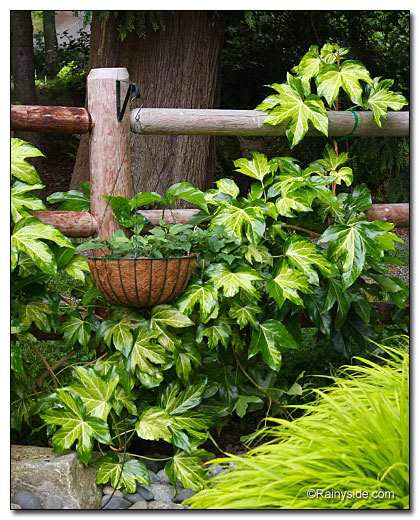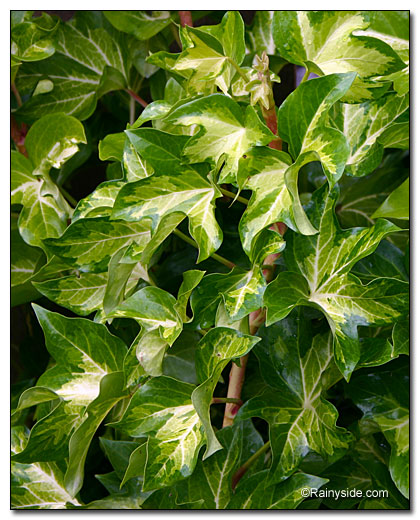Fatshedera lizei 'Aurea Maculata'
ARALIA IVY, BOTANICAL WONDER, TREE IVY
Family: Araliaceae
Quick Jumps
Growing Guide
Rainy Side Notes
GROWING GUIDE

Origin:
France.
Plant Group:
Shrubs.
Hardiness:
Sunset zones: 4-10, 12-24.
USDA: zones 8-11.
Mature size:
Height: 4-6 feet (1.2-2 m).
Width: 10 feet (3 m).
Flowering period:
Fall.
Flowering attributes:
Umbel-like panicles of sterile white flowers.
Leaf attributes:
Large deeply lobed (5-7 lobes) glossy leaves up 10 inches wide on red stems. Leaves are green with lighter green to white splotches in the center.
Growth habit:
Clump forming.
Light:
Full sun to light to partial shade.
Soil:
Moist, but well-drained (especially in winter), fertile soil.
Feeding:
Side dress with compost or manure in the fall. Fertilize monthly, spring through early summer with a complete organic fertilizer. If leaves continually turn yellow, provide iron.
Propagation Methods:
Greenwood cuttings in early summer with bottom heat. | Heel cuttings anytime of the year. | Semi-ripe stem tips in summer.
Pruning Methods:
Prune in late winter to early spring or in fall. Remove dead branches or if grown as a ground cover prune out any stems that try to grow upward. Pinch to encourage bushiness if growing as a shrub. Renew plant by cutting all the way to the ground in spring.
Pests and Diseases:
May be susceptible to fungal and bacterial leaf spots. Spider mites, and white fly may be problematic for the plant.
Rainy Side Notes

A rare moment in nature produced this inter-generic cross—Fatshedera lizei. The plant was originally found in France in 1910 growing in a nursery.
If you like the look of ivy, but you know it is not welcome in the Pacific Northwest because it is a thug causing major problems; here is an ivy crossed with fatsia that will work for you. Fatshedera looks like ivy on steroids but does not damage trees or anything in its path. Plus you have several options on how to grow this plant with beautiful foliage. Grow it as a vine by tying it up to a substantial support. Because of its wonderful tropical looking leaves that can get as large as 10 inches it looks superb growing up as a vine. You can also treat it as a shub and pinch it to encourage it to bush out. Or grow it as a ground cover by pruning out any upward growth. It also makes a great houseplant although I would rather see this growing outside in our maritime climate. Fatshedera is sterile and does not have clinging aerial rootlets so it doesn't climb without being tied up. I grow mine up a fence where it hides the tube for a water feature. Did I mention it has beautiful foliage?
It is semi-deciduous, new growth is damaged when temperatures go below 20°F and old growth at 15°F. Fatshedera will kill to the ground when temps go below 10°F, however, the plant readily resprouts. Hard frosts with temperatures in the upper twenties does not hurt the foliage.
Photographed in author's garden.
A Pacific Northwest Plant of the Week (2012)

Gardening for the Homebrewer: Grow and Process Plants for Making Beer, Wine, Gruit, Cider, Perry, and More
By co-authors Debbie Teashon (Rainy Side Gardeners) and Wendy Tweton

